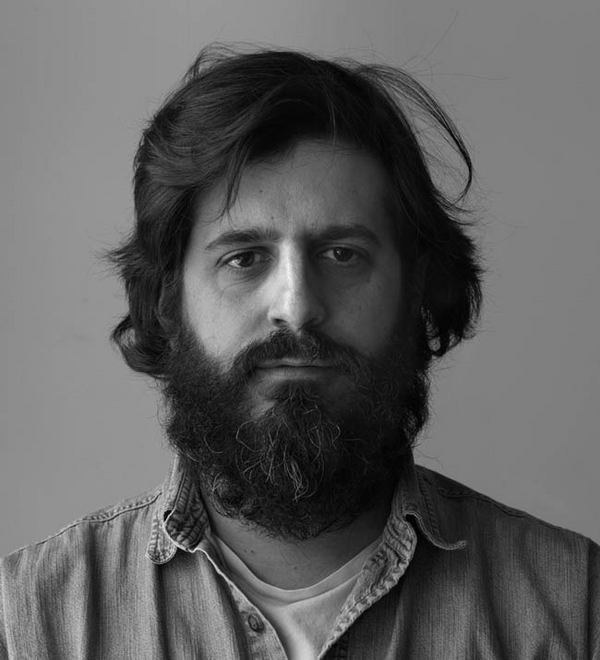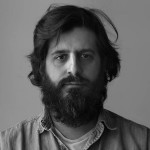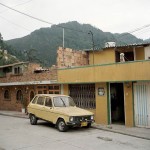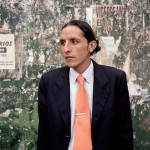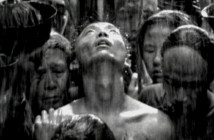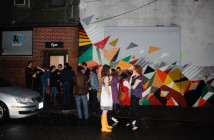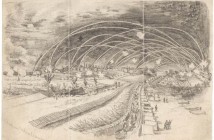Alec Soth is a prominent contemporary photographer who first gained acclaim with his seminal book, Sleeping By The Mississippi. Since its publication in 2004, Soth has published a number of photography books, including Niagara in 2006 and The Last Days of W in 2009.
Represented by Gagosian Gallery in New York, Soth is also a full member of Magnum, as well as a frequent lecturer at schools and conferences. Soth sat down for a conversation with Big RED writer Ben R Sloat before his talk at Mass Art on October 26th.
His show Dog Days Bogota is on view at the Paine Gallery at Mass Art until November 28th.
BRS: I saw Sleeping By The Mississippi as being fairly provocative in a certain way, given that area of the country has not really been shown in photographs and I never really thought about the northern states, like Iowa or Minnesota, as being part of the Mississippi. Also, the way you combined subject matter in the book, still lifes, portraits, landscapes, was unique.
AS: I did come out of this tradition of seventies color photographers, I hopefully brought my own little thing too. Some of that was that I wanted to be free to photograph everything: landscapes, still lifes and all that. Since I do live in the middle of the country, I bring in that part. I'm glad you mentioned the images of the northern states.
I just had a show in New Orleans, in an excellent gallery called the Arthur Roger Gallery. They just wanted to show work from lower half of the Mississippi for some reason, so they did, it's a nice show. I just got the worst review ever (laughs) the other day, it just sucks. One of the things he talks about is the Southern clichés. It just occurred to me how unfortunate it is that some of the northern pictures aren't there. I do think that maybe that would offset this writer's opinion.
BRS: I'm surprised the writer's opinion matters.
AS: So am I, it doesn't matter that much. In terms of negative reviews, you think you're going to handle it, but it does matter a bit. I have big problems with Sleeping By The Mississippi, there's parts I love, but definitely things I would do differently now. When people point to those things you'd rather do differently, you feel, "I wish I could", but I can't.
BRS: In reaction to the work of the seventies color photographers, it seems that you're free from a lot of their constraints. I saw a talk where Joel Sternfeld spoke about being only able to afford to shoot one 8"x10" color sheet a day while making "American Prospects."
AS: With Mississippi, in particular, I had no money. I could take a few pictures of something that really affected the photography in big ways. After that, with a bit more money to play around with, I could take multiple versions of the picture. That's part of how I got better as a photographer.
I have this thing, the camera's on a tripod, it's like an easel "Ok, I can only take a couple, I gotta makes this great." Then I tried to get everything in the frame, which, in fact, is not a good strategy for photography. Its pulling stuff out of the frame is usually what you want to do, to simplify it. But I didn't know that. So that was one of the lessons learned.
BRS: When you were shooting the Mississippi project, a location that you know, how are your strategies different from when you shoot something like Niagara, or doing editorial work. Does your process differ, do some of your choices become stylistic?
AS: I did learn some things and employed them, certainly in editorial work one learns tricks. The big difference between Mississippi and Niagara is a pretty profound thing. One is several thousand miles long and one is this little four-mile area. I spent more time working in Niagara, the number of days, just driving in circles, these unhappy circles, looking at the same buildings, the same pavement, everything over and over again. There wasn't that freshness, every day waking up in a new place and a new scene. That hugely affected the photography: "how am I going to make something out of this tiny little area?" So there was that problem solving. Whereas, I could go on a roadtrip and there will be a freshness everyday, so you can problem solve in a different way.
I used the repetition of the beds, not really a stylistic trick, but a structure that I used for Mississippi. But it's not like it's the first time I took pictures, I had been doing photography for ten years before that.
BRS: At first glance, the unpredictability from one page to another in your books is really unique, from portraits to the falls, to love letters, hate letters. Students always ask me, "how did he shoot that? How did he get people to be nude for him?" It raises questions of what's behind the photographs, what it took to get made, the intentions there, the invisible parts of the photograph. Is that an important thing for the viewer to understand or is that elusiveness part of the work?
AS: This is the never ending struggle, I think storytelling is the most powerful art, for me. I just think there's nothing more satisfying than the narrative thrust: beginning, middle, and end, what's gonna happen. The thing I'm always bumping up against is that photography doesn't function that way. Because it's not a time-based medium, it's frozen in time, they suggest stories, they don't tell stories. So it is not narrative. So it functions much more like poetry than it does like the novel. It's just these impressions and you leave it to the viewer to put together.
One of the things I have in the lecture tonight is the Aristotelian dramatic arc, which shows an actual arc: building tension, climax, resolution. Then I did the photographic equivalent, which is just these dots, all over the place. For the viewer it's this game of filling in those dots. There's this struggle of how closely you put the dots together. I never know. Right now I'm experimenting with something else where I'm trying to tell a story, an actual story, for the viewer to figure it out what happens. Still you have to be very careful photographically, so it's not so obvious. Making those gaps, it's always the question.
BRS: Does a photograph inherently have aspects of nostalgia within in? I was recently in the rural South and didn't know if I wanted to photograph an old sign because I love the old sign or the Walker Evans photographs of old signs.
AS: That's a real problem. We all do that, we photograph things because that looks like photographs. I do that all the time. Everyone starts, you photograph a barn, for example, because that's an idea of beautiful. I think that keeps changing with time, from Walker Evans to Eggleston, there's a new idea of what the cliché beautiful thing is, even if it's an empty parking lot. That's okay, I have no problem with that. What I do have a problem is, is the nature of the medium itself. In a world where the 2 billionth photograph has been uploaded to Flickr, which looks like an Eggleston picture! How do you deal with making photographs with the tens of thousands of photographs being uploaded to Facebook every second, how do you manage that? How do you contribute to that? What's the point? It's a real struggle.
BRS: But there's something very displaced about what a fine art photograph does, how it's shown...
AS: Even that's changing. In the early days of photography, you basically needed to be a scientist to do it, now it's getting easier and easier, but still, you needed a certain access to something. There were amateur photographers, but it's to a whole different level now. This has huge implications on photojournalism. The majority of great photojournalist images are amateur images now, because they are at the right place at the right time with a camera, how do you compete with that?
BRS: In photo history that's true too, the Lewis Payne photo from after the Civil War era where he's bound, that's one of the greatest photos of all time.
AS: But more and more now, everyone has a camera at every situation, what's the point of documenting? Why should I go to Iran now and try to document something where there are people already there documenting all the time? And that's my feeling of documenting as whole. Doing every building on Sunset Strip, we can go to Google Earth and see that right now.
BRS: But the cache of seeing it from 1965 before Guns N Roses showed up...
You ask an interesting question, can contemporary photography find its way back to something physical, is that necessary since the digital process is so seamless?
AS: You can feel struggle with what to do in this world with billions of pictures. I think there's a strain of photography going for something more physical, so you're seeing a lot of cut up, photograms, one of a kind objects. I'm naturally a sucker for that, because I like that stuff, but I don't think that's a long term answer, it's just a side effect. I think there is a hunger merging these pictures, how to tell stories, how to use new technology online to do it. This is more in photo journalism circles, but I see it in fine art photography too, aching to get beyond the single picture. I see these two things happening. If I were 20 years old, I think I'd be on the cusp, like being a photographer in 1942. An incredible revolution is taking place, it's very exciting, and no one's figured out how it's going to work, but something's big is going to happen.
BRS: Do you see a greater disconnect between the act of photographing and the photographic object? I know you've discussed the difference between the phenomenon of photographs for a wall versus those that are meant to be seen in a book. Maybe the third aspect is the process itself of making a photograph.
AS: Absolutely, before I got into photography I did earthworks, very derivative of Richard Long, but I love that work. I feel like I'm coming full circle, back to it where it's all about process. The answer that I'm slowly working on to the 2 billion pictures on my back thing, which is getting rid of the picture. It's just this thing in the book about the process, the art is the process. It's another answer for those experiences about being out in the world, versus the object itself.
My big theory is that in photography it doesn't function as a narrative, but the photographer takes the place of the protagonist in the story, and you take the place of the photographer. I use the example of the last picture in the Americans, where Frank shows the picture of his child and his wife in the car. That picture makes you really think about him, about the journey. That's what gets me excited about photography.
BRS: One challenge of mine is that I love Nan Goldin's Ballad of Sexual Dependency, but I can't really look at it anymore. Then I'm balancing that against a William Carlos Williams poem you mentioned before, where he's dancing while his family is asleep, and how it never has a reference but photography always has a reference. I wonder about that, not as a problem, but as an interesting condition.
AS: I think that's a really great point. I have a big library of books, but do I go back to those books all the time? I think some of them are supposed to sit there for years and exist in my imagination. I remember pieces of them and when I'm ready for it, I go back again. When's the last time I pulled out The Ballad? I like it to exist as an idea, I like the pictures, but I like the ideas of it more so. It connects very much to the Earthworks thing of existing in the imagination. I think we all do this. For a lot of people it does function like William Carlos Williams dancing around, they're not referring to the actual thing, they're referring to the idea of it. The idea of Nan Goldin's circle, and that world, and that time.
Then there's also the world of the collecting, which is always about the picture, the unique object. I like that world too. I don't collect photographs, but I appreciate the desire for the great unique object, but that's not at the forefront of my interest.
My aim is to try to make a great book. That's what I want to do. And what does that mean? I have no idea what a great book is. What I do know is that it isn't a formula. It's like a great album, maybe the band has to spend three years in the studio doing it or maybe it's live in one take over a weekend. Knowing it's not a formula, I know that I have to keep shaking these up, so I do something fast, then do something that takes years, trying different things. Do the stuff where I work alone, do the stuff where I work collaboratively. Sometimes it will fall flat, but hopefully magic will strike at some point.
- Alec Soth
- Untitled 08, Bogota, 2003. Alec Soth/Magnum Photos
- Untitled 38, Bogota, 2003. Alec Soth/Magnum Photos
"Dog Days Bogota" is on view September 9 - November 28, 2009 at MassArts Stephen D. Paine Gallery.
All images are courtesy of the artist and MassArt.

